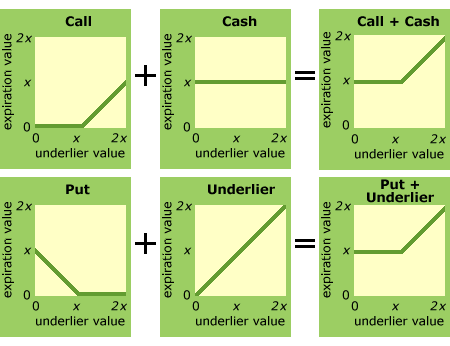What Is a PutCall Parity (with picture)
Post on: 5 Июль, 2015 No Comment

These 10 animal facts will amaze you.
Adorable animal families that will make you aww.
These 10 facts about space will blow your mind.
Put-call parity refers to an investing theorem in option pricing to identify a fair price for a put option or a call option. According to this theorem, there is a relationship between the prices of a call and a put, which ensures that no arbitrage opportunity exists. If put-call parity holds, no trader can make a risk-free profit by simply taking advantage of the price differences between a put option and a call option.
The put-call theorem involves four financial instruments: a put option, a call option, an underlying asset and cash. A call option gives its owner the right, but doesn’t require him, to buy a certain amount of the underlying asset at a certain exercise price within a certain timeframe. A put option provides the right, but no requirement, to sell a particular amount of the underlying asset at a certain exercise price within a certain timeframe. The underlying asset can refer to a stock or items such as gold, oil and agricultural products. The cash, in this case, would amount to the present value of the options’ exercise price.
Put-call parity holds that a portfolio consisting of a call option and the cash is equal in value to a portfolio consisting of a put option and the underlying asset. A trader, therefore, would get no profit out of the risk-free transaction of buying one portfolio and selling the other portfolio. If prices are out of balance, traders would come to make profitable, risk-free transactions until put-call parity is restored.
In mathematical terms, put-call parity can be represented by the formula C + X/(1+r) t = S0 + P. C and P stand for the price of the call option and the put option, respectively. X/(1+r) t represents the cash or the present value of the options’ exercise price. S0 represents the price of the underlying asset. Using the formula, a trader can find the fair price of an option and determine whether there is an arbitrage opportunity.
For example, if the trader knows the price of a three-month call option with an exercise price of $30 US Dollars (USD) is $3 USD and the underlying asset is priced at $31 USD when the risk-free rate is 10 percent, he or she can find the fair price of the corresponding put option. The formula would be 3 + 30/(1+0.1) 0.25 = 31 + P. Calculating P from the formula, the trader finds that the fair price of a three-month put option with an exercise price of $30 USD is $1.29 USD. If the actual price of the put option is above or below that value, then the trader can profit by buying the underpriced portfolio and selling the overpriced portfolio.
Put-call parity theorem needs several conditions to work. The call option and the put option have to have the same exercise price, the same underlying asset and the same expiration date. The options have to be European options, which only allow the owner to exercise them at maturity and not before. The theorem also assumes that the interest rate is constant. Although deviations from put-call parity exist in real life, studies show that the presence of bid/ask spreads and commissions neutralize arbitrage profits.














